original:State of Solana Q3 2023
Author: Peter Horton
Compiled by: 0xSekiro
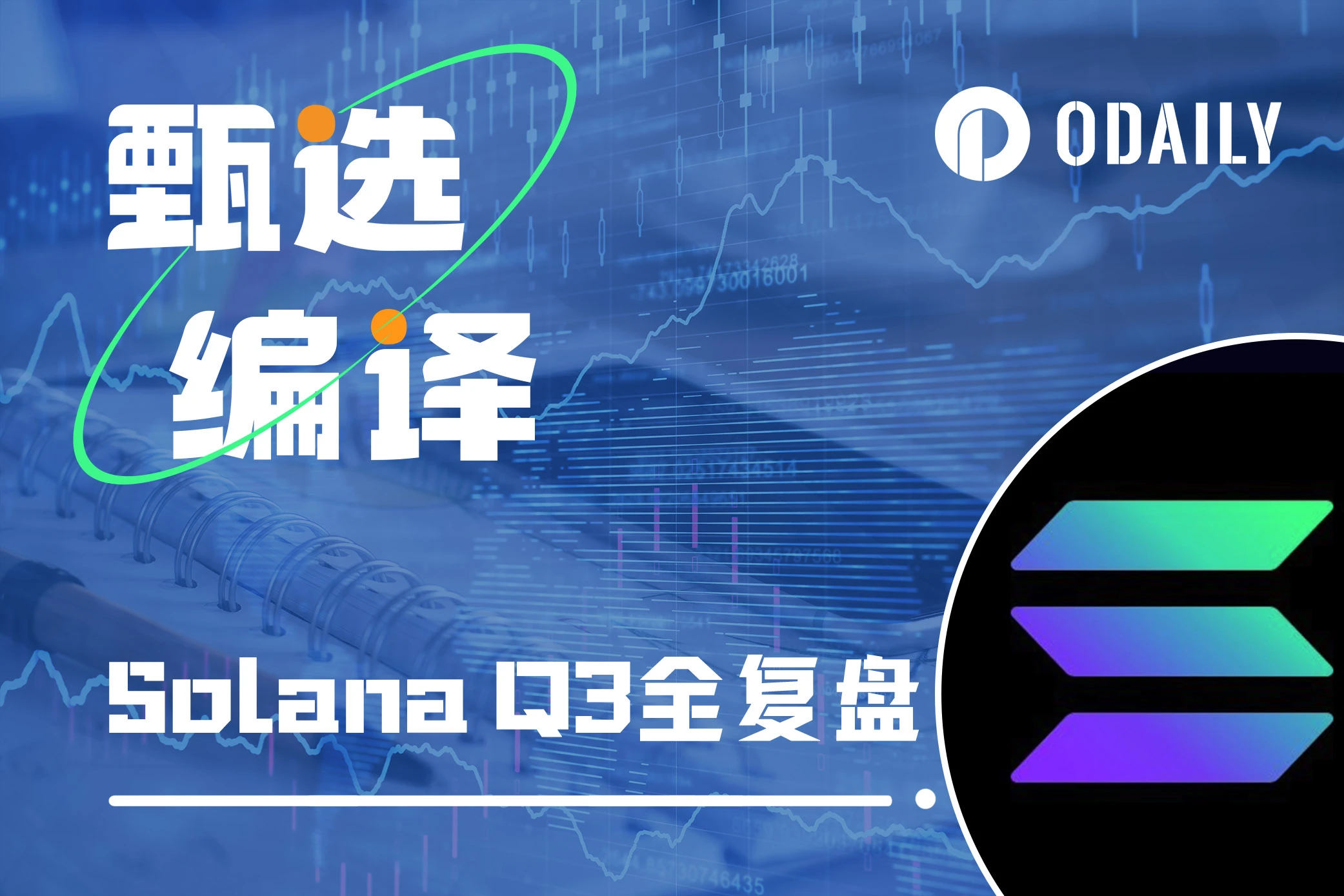
Solana, as an ecosystem closely related to FTX/SBF, has also experienced greater pressure and impact during the FTX thunderstorm incident. But times have changed, and just as SBF is still in the midst of a lawsuit with former Alameda Research CEO Caroline Ellison, it’s hard to extricate itself. Solana seems to have emerged from the shadows with newer achievements. The author of this article, Layer 1 protocol analyst Peter Horton, is approaching the first anniversary of FTX’s “Black Swan”. He uses detailed data and examples to explain to us what Solana has done in the past year. , what is the current situation? What opportunities and potential will there be in the future? Perhaps through this article, we can also have a clearer understanding of Solana.
The following is the original text of the report, compiled by Odaily.
Key takeaways
In Q3 this year, the minting volume of compressed NFTs (cNFTs) reached nearly 45 million, a month-on-month increase of 316%.Free collectibles publisher DRiP accounts for 87.5% of these, followed by Dialect and Helium.
Solanas virtual machine (SVM) and technology stack are gaining attention and adoption from outsiders. For example, in the third quarter of this year, Rune Christensen, the founder of MakerDAO, published an article in the community titled Exploring the Solana Code Base Fork for NewChain; Eclipse announced the Layer 2 mainnet architecture supported by SVM; and Visas development in Solana Payment integration on.
Solana’s total DeFi locked value increased 32% month-on-month to $368 million.Growth has been driven by points programs launched by DeFi and liquid staking protocols, led by MarginFi, Jito, Cypher and BlazeStake.
The V1.16 upgrade reached a super majority equity share at the end of the quarter. The upgrade reduces validator node memory requirements, introduces functionality and features required for confidential transfers, and improves support for zk-proof.
Despite concerns that FTX may liquidate its more than 57 million SOL tokens, SOLs market capitalization still increased by 17% month-on-month to $8.4 billion.FTX/Alameda’s SOL tokens are subject to various unlocking schedules, with an average unlock date in Q4 2025.
Introduction to Solana
Solana is an integrated, open-source blockchain designed to synchronize global information efficiently at the speed of light. Solana uses features to optimize latency and throughput at the expense of some verifiability. It achieves this through features such as its novel timestamping mechanism called Proof-of-History (PoH), block propagation protocol Turbine, and parallel transaction processing. Since mainnet launch in March 2020, (Solana) has further improved network performance and resilience through several network upgrades, including QUIC, stake-weighted quality of service (QoS) and local fee markets.
The Solana Foundation, Solana Labs, and third-party teams such as Helius and Superteam further drive the development and growth of the Solana network and ecosystem.To date, Solana Labs has raised over $335 million in private and public token sales, and its ecosystem spans projects across many sectors, including DeFi, consumer, DePIN, payments, and privacy.
Key indicators
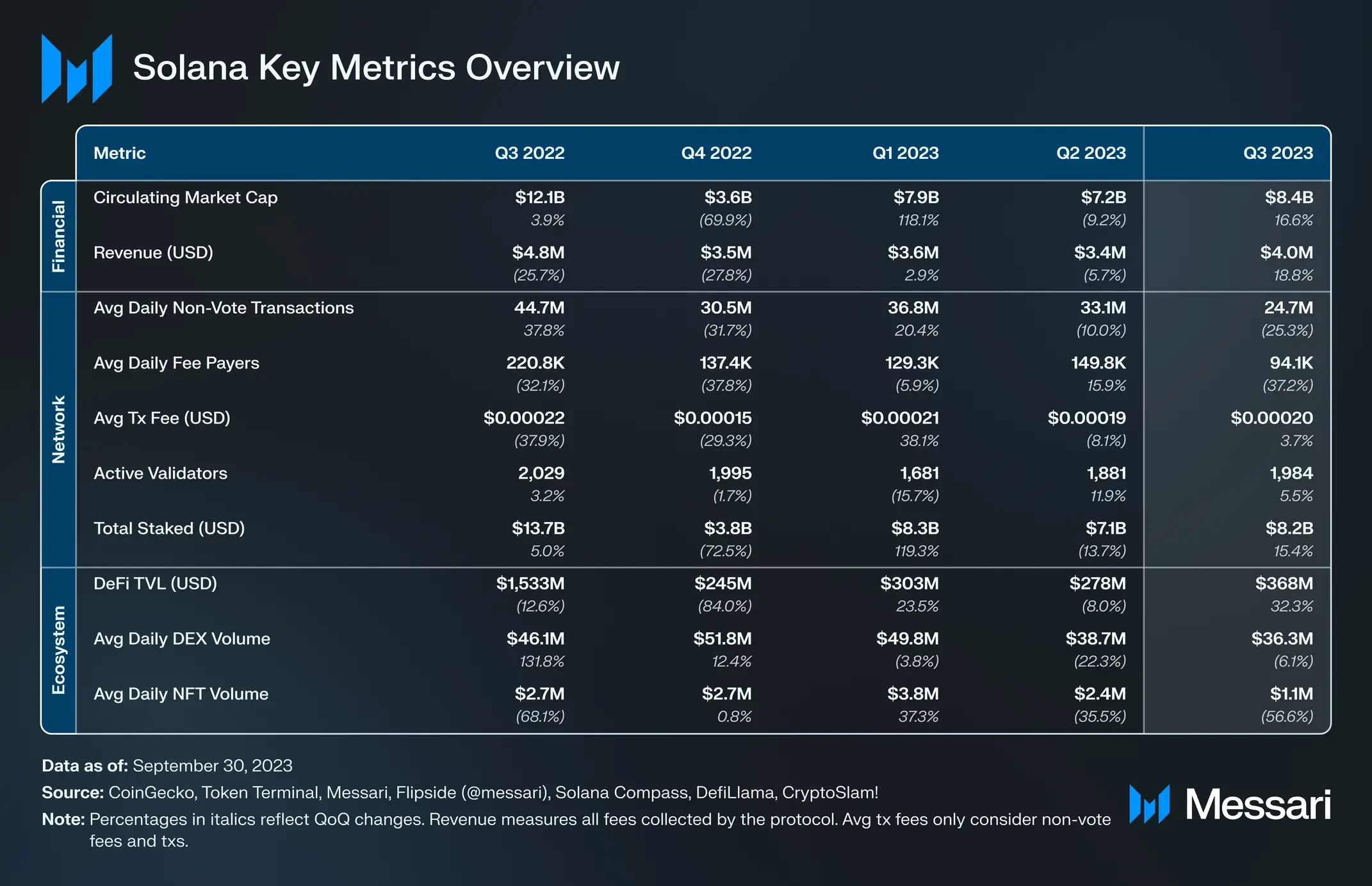
financial analysis
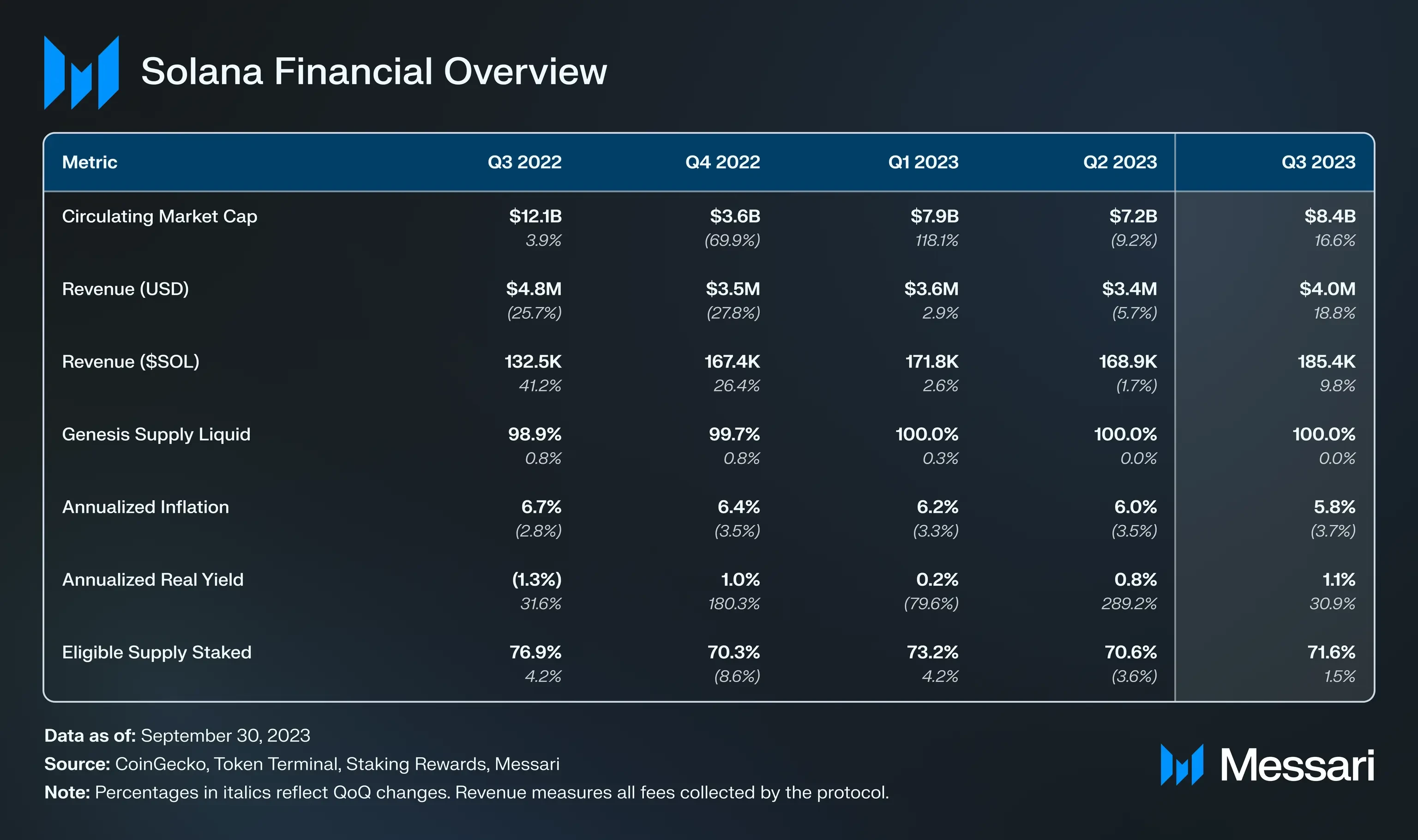
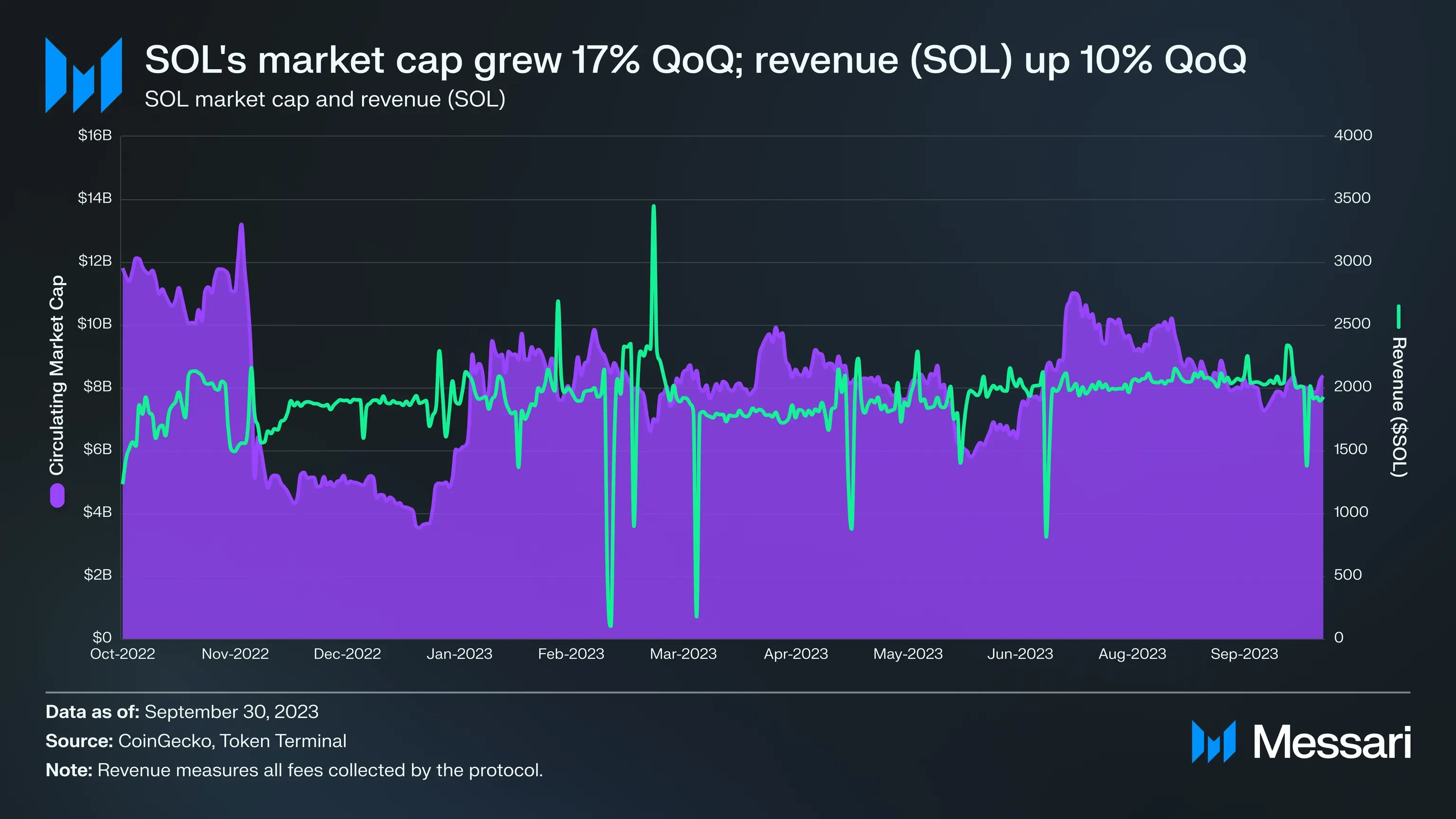
In early June, the SEC filed regulatory complaints against Coinbase and Binance, designating assets such as SOL as securities. These complaints resulted in a 34% drop in SOL prices. However,Compared with other tokens recognized as securities during the same period at the end of the second quarter, the SOL token performed stronger, and continued this momentum into the third quarter. Possibly due to the potential liquidation risk of FTX/Alameda on SOL (more on this below), SOL experienced a brief decline, but at the end of the third quarter, SOLs market value still reached $8.4 billion, a 17% increase from the previous quarter. It is worth noting that due to SOL’s outstanding performance among assets with similar market capitalization, its market capitalization ranking has also risen from tenth in Q2 to seventh.
In U.S. dollars, Solana protocol fee revenue increased by 19% to $4 million, and in currency-based SOL terms it increased by 10% to 185,400. In Solana’s system, half of the protocol fees will be burned and the other half will be distributed to block producers. So far, these burned tokens have not significantly reduced inflation, which ended the quarter at 5.8% when strictly measuring the issuance of new tokens based on validator rewards and excluding other unlocks.
Currently, the Solana inflation rate will continue to decrease by 15% every epoch until it eventually stabilizes at 1.5%.As of this writing, 71.6% of the total stakeable SOL is staked to avoid dilution from unlocking (new tokens). It should be noted that although the SOL held by Solana Labs or the foundation is in an unlocked state, not all of it is included in the circulation. Taking into account uncollateralized tokens and nominal yields above inflation, SOLs real annualized returns ended the quarter slightly positive at 1.1%, up 31% sequentially.
Although the SOL initially unlocked is liquid, actions with a re-lock nature such as Grant or token purchases will also bring inflationary pressure. It should be noted that FTX/Alameda previously purchased more than 57 million SOL from the Solana Foundation and Solana Labs. The accounts in which these tokens are located are subject to various unlocking plans and can be traded over-the-counter, but the unlocking date is in 2025. Q4. Currently, FTX has been granted permission to liquidate its crypto assets during a pretrial hearing on September 13. As a result, in the lead-up to the hearing, SOL experienced negative price movements, especially in the derivatives market, with a significant increase in open interest in options in the short direction and funding rates close to where they were during the year.
network analysis
usage data
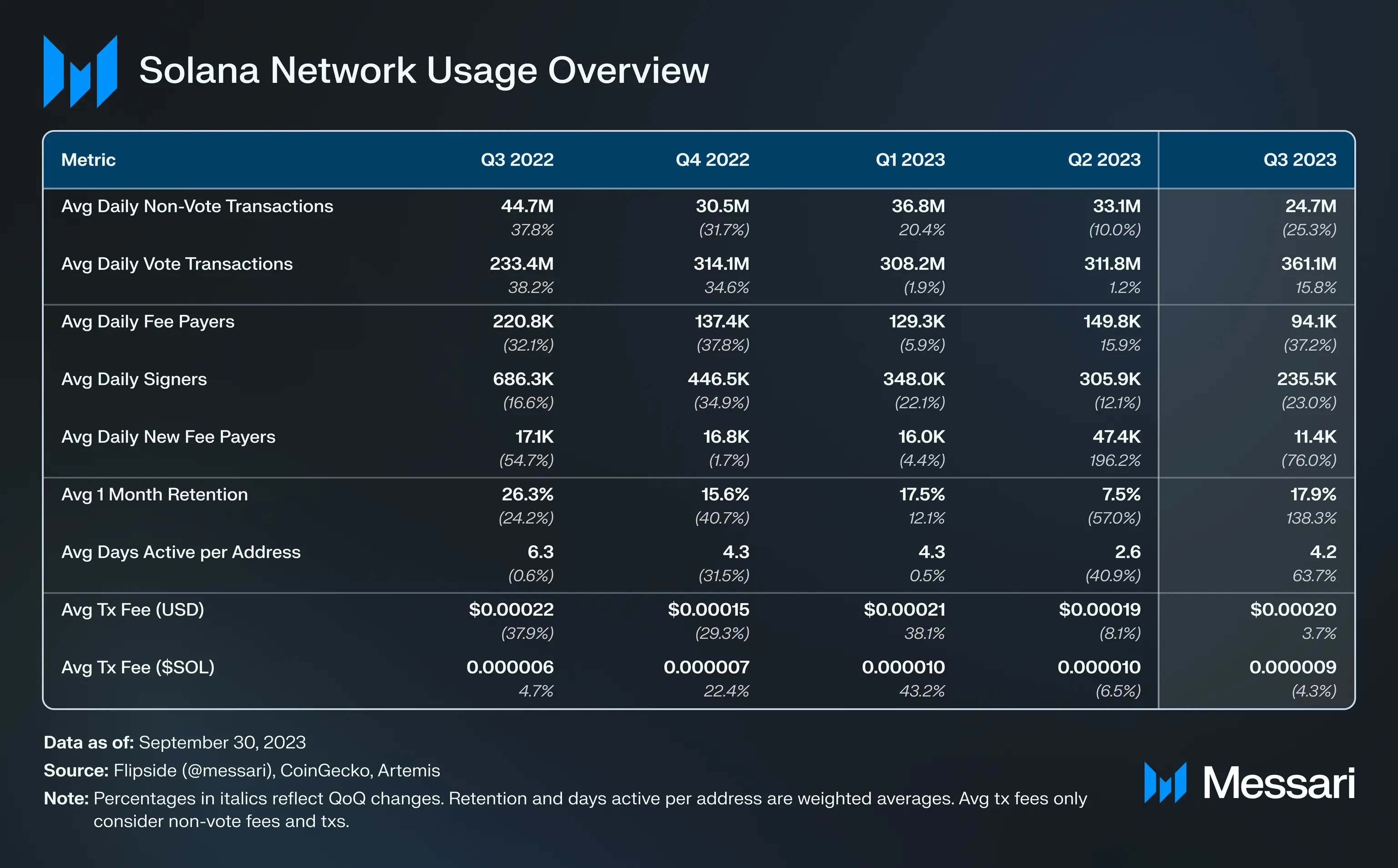
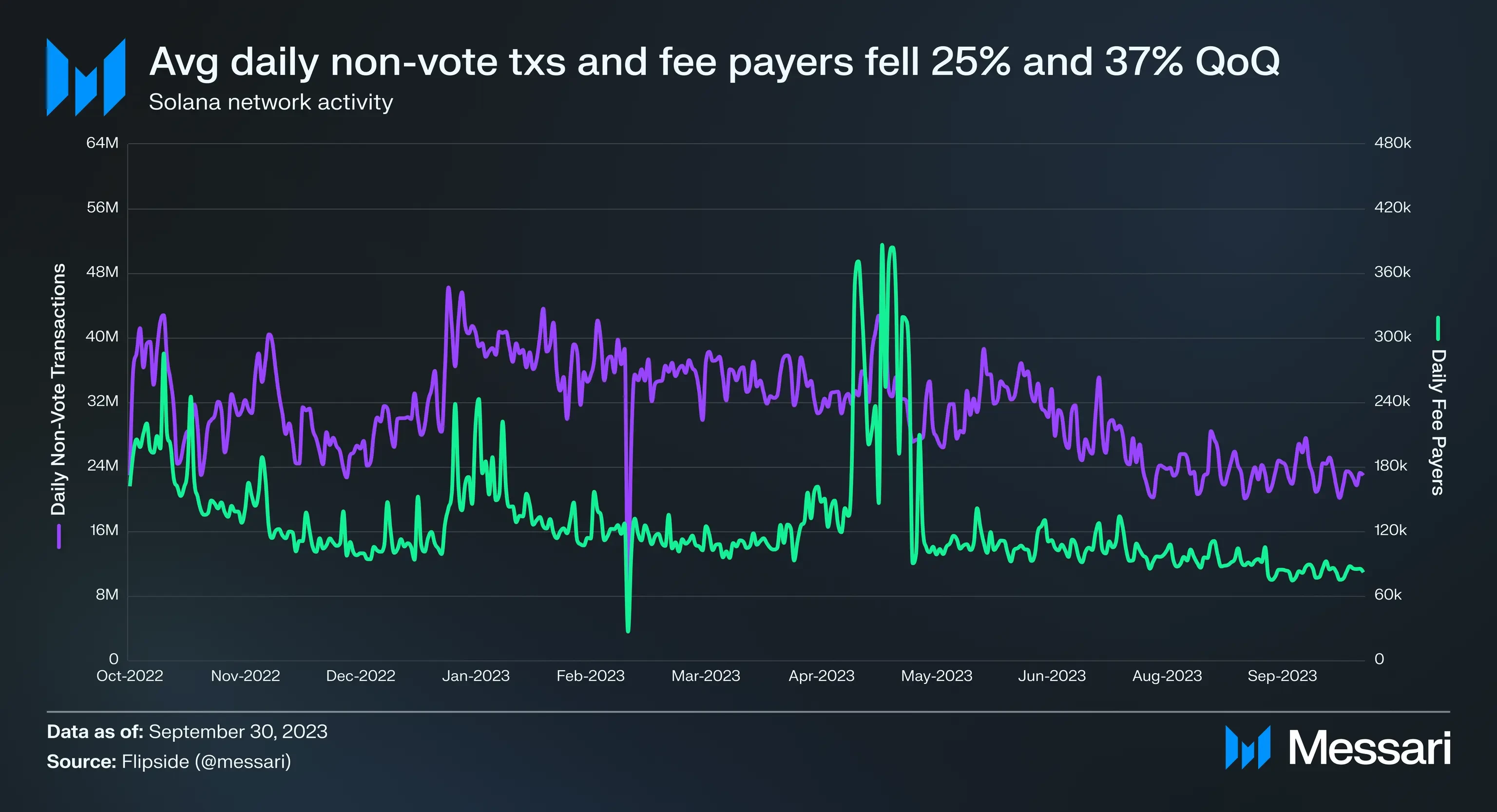
Ecosystem activity, measured by the number of non-voting transactions and payers, declined month-on-month and reached its lowest level at the end of the year (excluding the network failure on February 25, 2023). Among them, the average daily non-voting transaction volume fell 25% month-on-month to 24.7 million, while the average daily number of payers fell 37% month-on-month to 94,100 people. In the case where ecological projects subsidize user gas fees, the number of users is underestimated. In fact, the average number of daily signers also declined, to 235,500, a 23% month-on-month decrease.
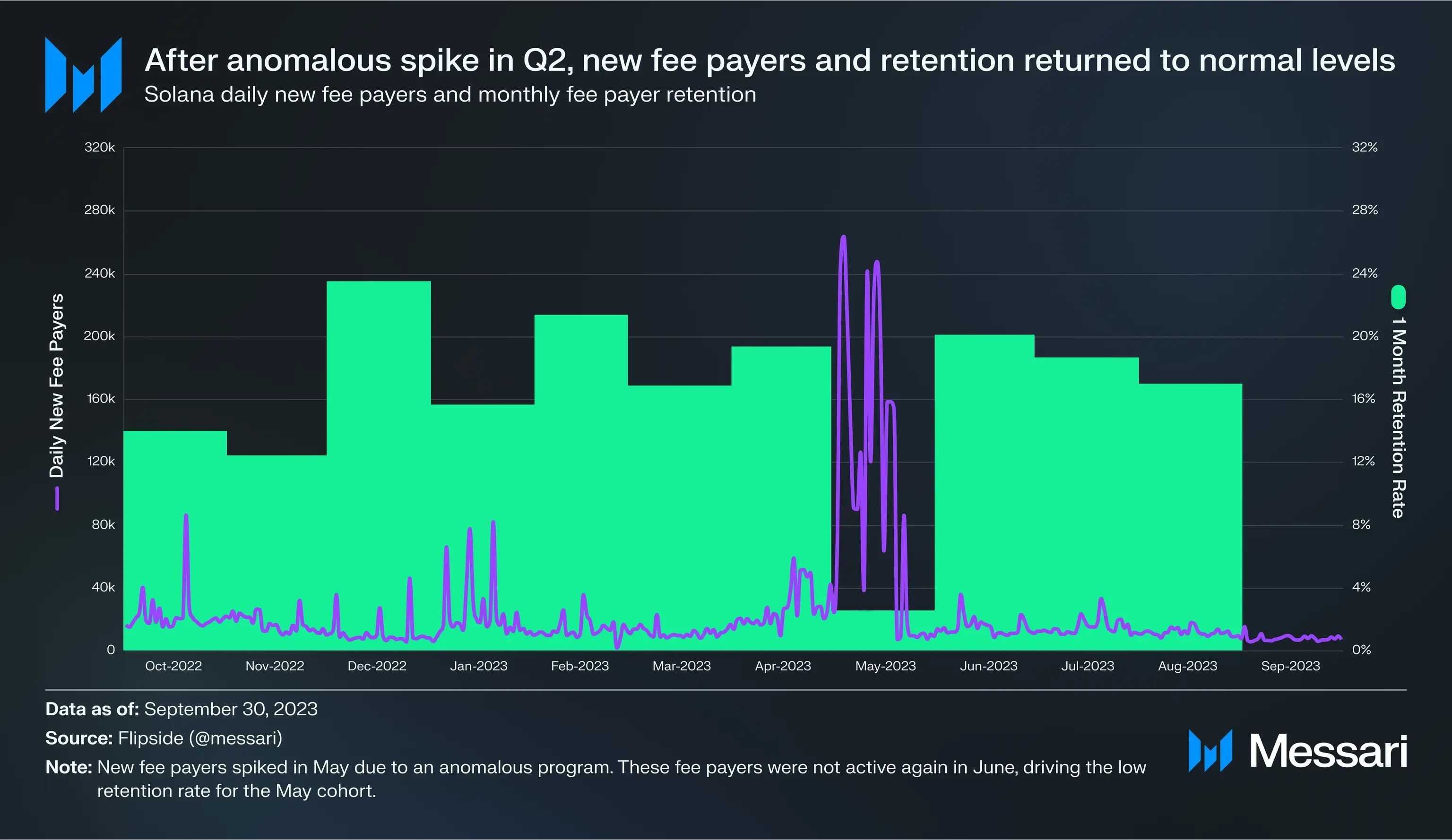
The average number of new paid users per day dropped even more significantly from the previous month, falling by as much as 76% to 11,400. The sudden increase in Q2s numbers was caused by unusual activity from an unknown project. The app created many new addresses in mid-May, but by June, these new addresses were no longer active, resulting in a retention rate of just 0.0% for new users in May. is 2.5%, which is much lower than the average monthly retention rate of 17.9% in Q3.
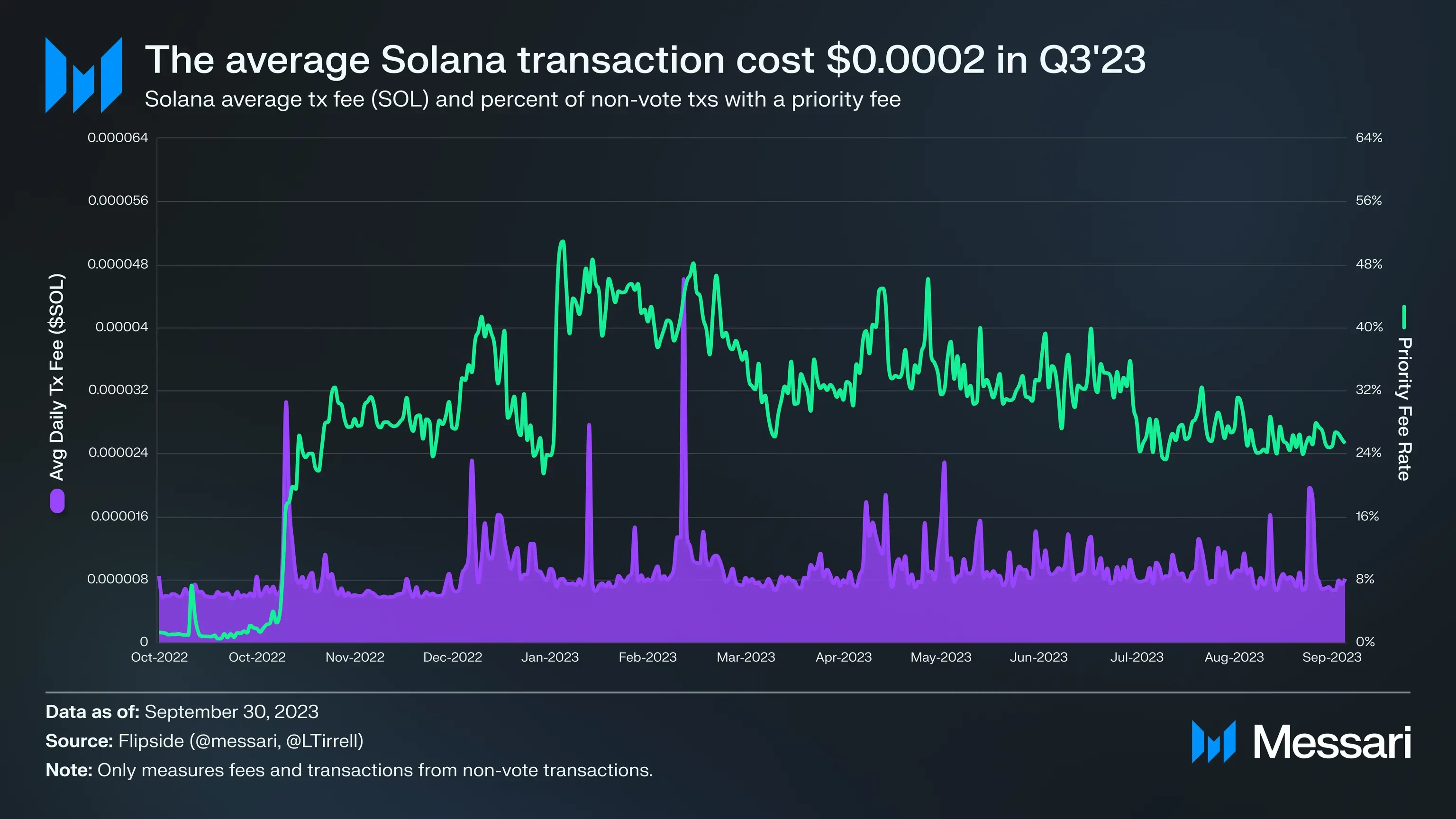
Solana’s transaction fees are still one of the most stable and cheap ecosystems. The average non-voting transaction fee in the third quarter of this year was $0.0002.Prioritized fees reduce spam and synchronize with local fee markets to prevent network congestion. But since many wallets and apps integrated the feature in Q1 2023, the proportion of non-voting transactions with priority fees has gradually declined.
Security and decentralization
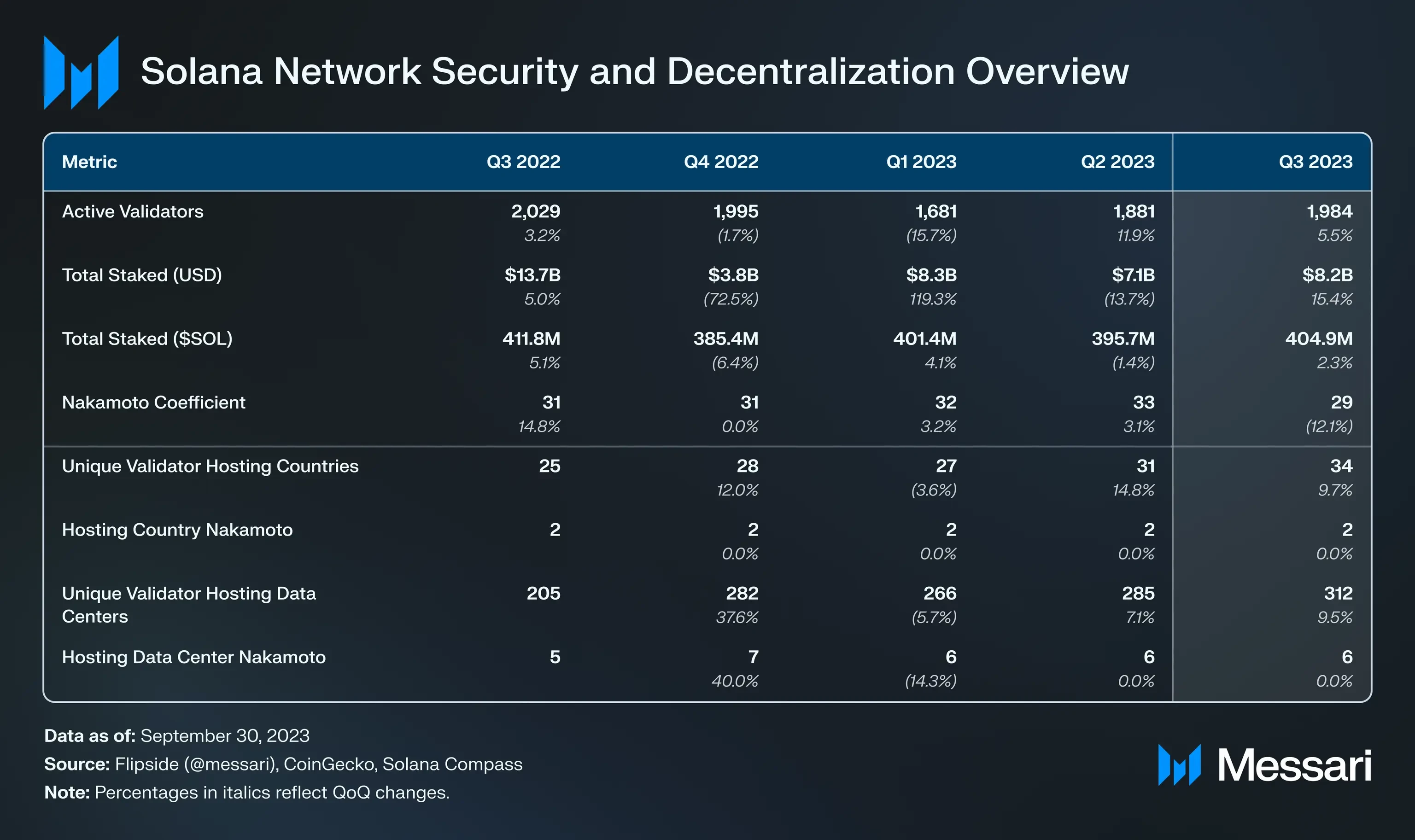
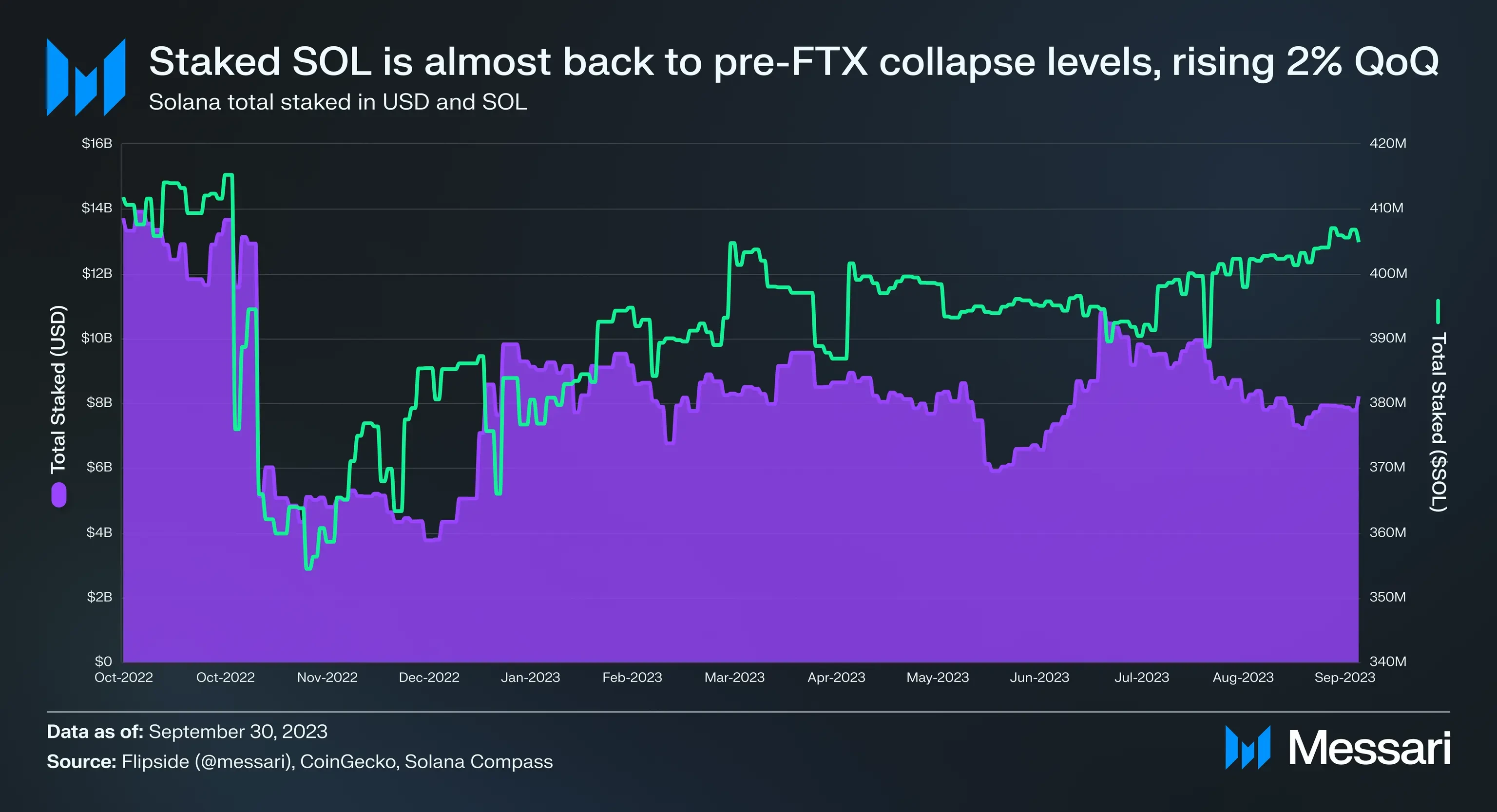
SOL’s total mortgage volume continued to rise during the quarter, growing 2% to reach 404.9 million, returning to pre-FTX levels. At $82 billion in market capitalization (SOL current price of $23.68), Solana ranks second in terms of total token collateral market capitalization, behind ETH.
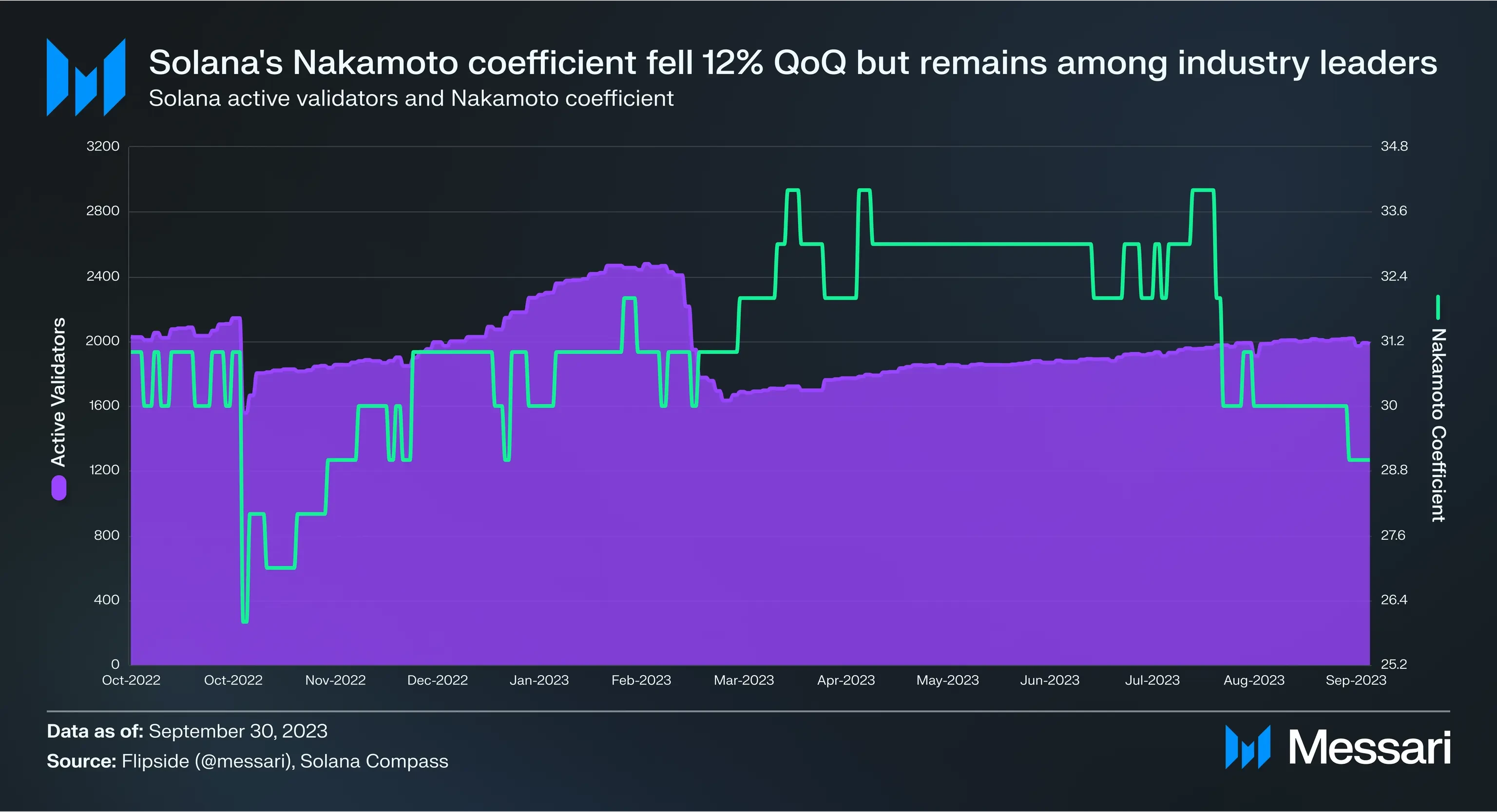
Solanas Nakamoto coefficient, a statistic used to quantify the degree of decentralization of various blockchains, fell 12% sequentially to an industry-wide 29, still leading the industry. The number of validators increased slightly, up 5.5% month-on-month to 1,984. In Solana’s October validator report, the Solana Foundation planned to make changes to the validator delegation scheme to encourage higher node quality rather than quantity. There are currently over 73 million SOL in the entrustment program.
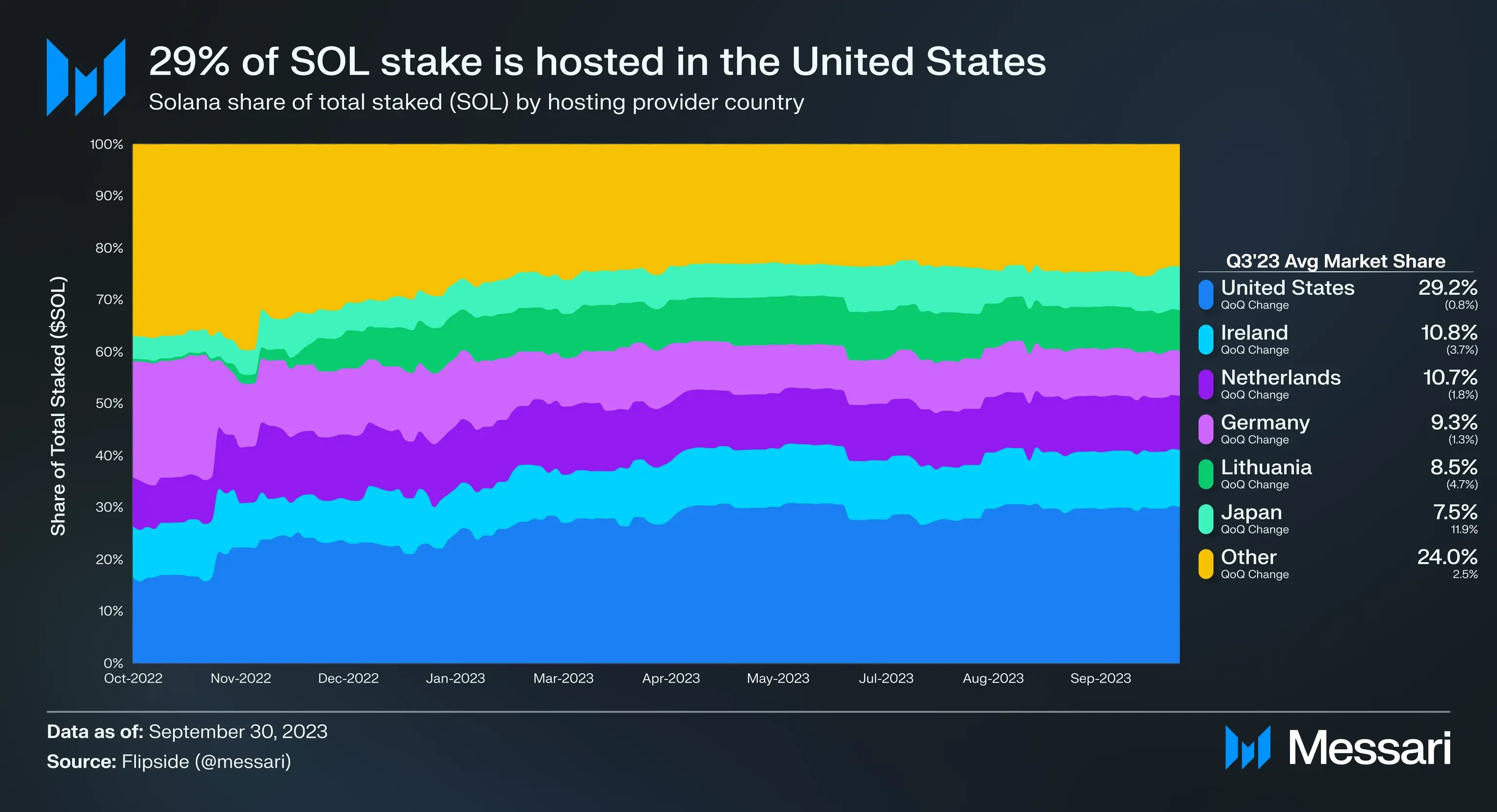
The Nakamoto coefficient is the minimum number of nodes required to stop network/disrupt activity. In addition to being checked across all nodes, it can also be measured by other dimensions critical to the resiliency of a validator network, including stake distribution by location, hosting provider, and client distribution.
Currently, Solana has validators in 34 countries, an increase of 10% month-on-month and 27% year-on-year. The United States (certifiers) account for 29% of all equity and are in a leading position in the Solana ecosystem. Being close to the 33.3% threshold, this gives Solana a geographic Nakamoto coefficient of 2. The Solana Foundation noted in its recent validator report that it plans to address the increase in U.S. share over the past year as it approaches the 1/3 threshold.
Solana’s validators are hosted in 312 unique data centers, up 10% quarter-over-quarter and 34% year-over-year. Solanas data center has a Nakamoto factor of 6.
As noted in the Validator Report, Solana’s hosting provider Nakamoto has a factor of 3 and consists of TeraSwitch, AWS, and OVH.
Currently, Solana has two clients: the original Solana Labs client and Jito Labs’ MEV-optimized fork. Shortly after the quarter ended, Jito clients share exceeded 1/3. However, it doesnt have the same client diversity as a client written from scratch. There are currently two clients being written from scratch for this purpose: Firedancer and Sig.
Jump Crypto is developing Firedancer in C++. Given that timelines for engineers are hard to come by, Toly recently estimated that Firedancer would be live on testnet before the end of the year and on mainnet about six months later. In addition to client diversity, Firedancer may also bring performance improvements. It maintained a throughput of over 1 million tps in a test environment, compared to around 55,000 tps for the Solana Labs client in a similar environment.
Sig is a new client announced at the end of July this year. Syndica is leading the development of Sig, which will be written in Zig. Sig optimizes RPC reads designed to reduce Solanas slot lag. It also focuses on readability and simplicity, hopefully making it easier to understand for developers.
The lightweight client TinyDancer is also under active development. TinyDancer will increase the trustworthiness of the network by allowing users to verify status without having to run a full node themselves.
Finally, although it is difficult to measure, the Solana Foundation has noticed a significant increase in participation in the validator network. Examples of its spending include: a community-led Reading validator conversation starting in March 2023; and the Block Zero conference for Solana validators during Breakpoint Q4.
Performance, upgrades and roadmap
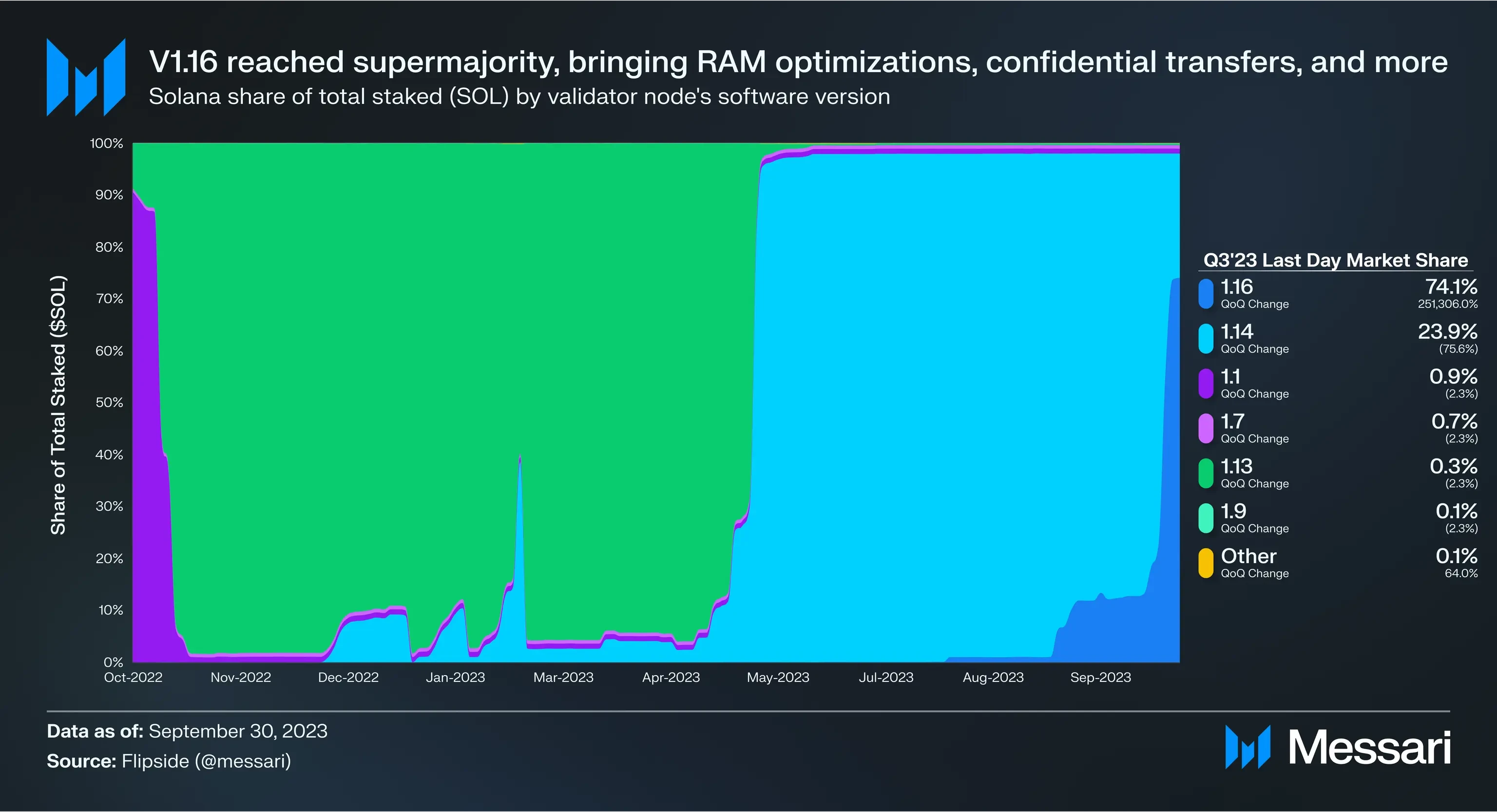
Validators will switch to the V1.16 upgrade starting from the end of August this year. Although there were some minor bugs, they were fixed with the help of the community. Starting from Epoch 510 on September 28, the vast majority of validators have started operating new software. Validators noticed a significant memory reduction after the upgrade. Additionally, in addition to RAM optimization, other new features in V1.16 include:
Support SPL Token 22 confidential transfer. Confidential transfers use zero-knowledge (zk) proofs to encrypt the balance and transaction amount of SPL transfers. Users can provide read access to other accounts, achieving confidentiality while ensuring auditability. Confidential transfers will be enabled on mainnet beta in late 2023.
Improved efficiency in verifying zk proofs and supports 128 elliptic curve operations (equivalent to EIPs 196-198).
For more information on the V1.16 upgrade process and features, please see thisHeliusarticle.
V1.17 is expected to be available in early Q1 2024, which will bring additional zk support and may include Poseidon system (a log retrieval tool) calls.
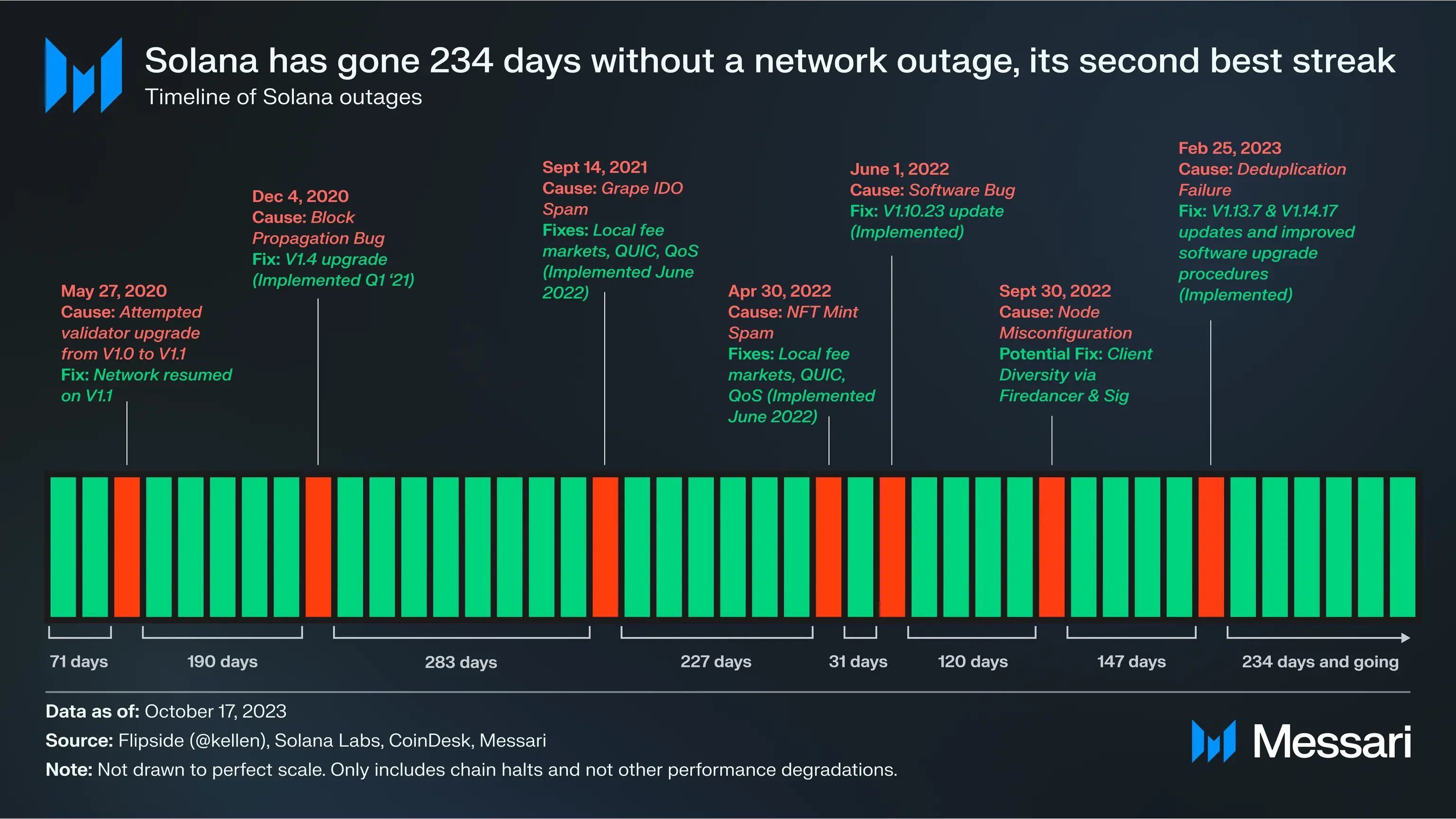
The Solana ecosystem is approaching its longest continuous online time since the outage occurred on February 25 this year. This achievement is the result of improvements to the upgrade process and new technology features over the past year, such as QUIC, stake-weighted QoS and local fee markets.
The strong performance of SVM and Solanas overall technology stack have attracted attention from the outside world. SVM adoption outside of Solana includes:
MakerDAO: In Q3 MakerDAO founder Rune published a forum proposal exploring the use of SVM forks as backend power for the Maker protocol and its child DAOs. Rune noted that after extensive research, he determined Solana was the most promising code base for several reasons:
Technical quality (optimized integrated blockchain)
Multiple client implementation
Strong ecosystem and thriving developer community
The history of forks used in application chains such as Pyth
None of the measures are yet complete. So despite MakerDAOs decision to pursue a different solution, Runes post is a testament to the quality of Solanas technology and its open source nature.
Eclipse: Eclipse was originally a Rollup that provided SVM as an execution environment. In mid-September, it announced its transition to a general-purpose Layer 2 powered by SVM. While some tried to view this as a victory for Ethereum at Solana’s expense, many Solana community members celebrated the announcement.
Rome: Rome Protocol is a shared sequencer that leverages Solana launched at the end of the quarter. This shared sequencer network will be deployed as smart contracts on Solana, with each Rollup deployed using its own Neon EVM.
Neon EVM is an EVM engine deployed on Solana. Its mainnet went live in mid-July. The network averages about 22,000 transactions per day, and it’s worth noting that more than 80% of Neon’s total transactions come from its surge activity. And upon launch, Neon received some criticism from members of the Solana community due to its token economic model.
Two days after Neon went live, Solana Labs released a compiler for Hyperledger Solang, allowing developers to write Solana programs in Solidity. Compared with Neon, which allows developers to write EVM contracts that run in the Solana ecosystem, Hyperledger Solang does not support Rust or C language.
ecological analysis
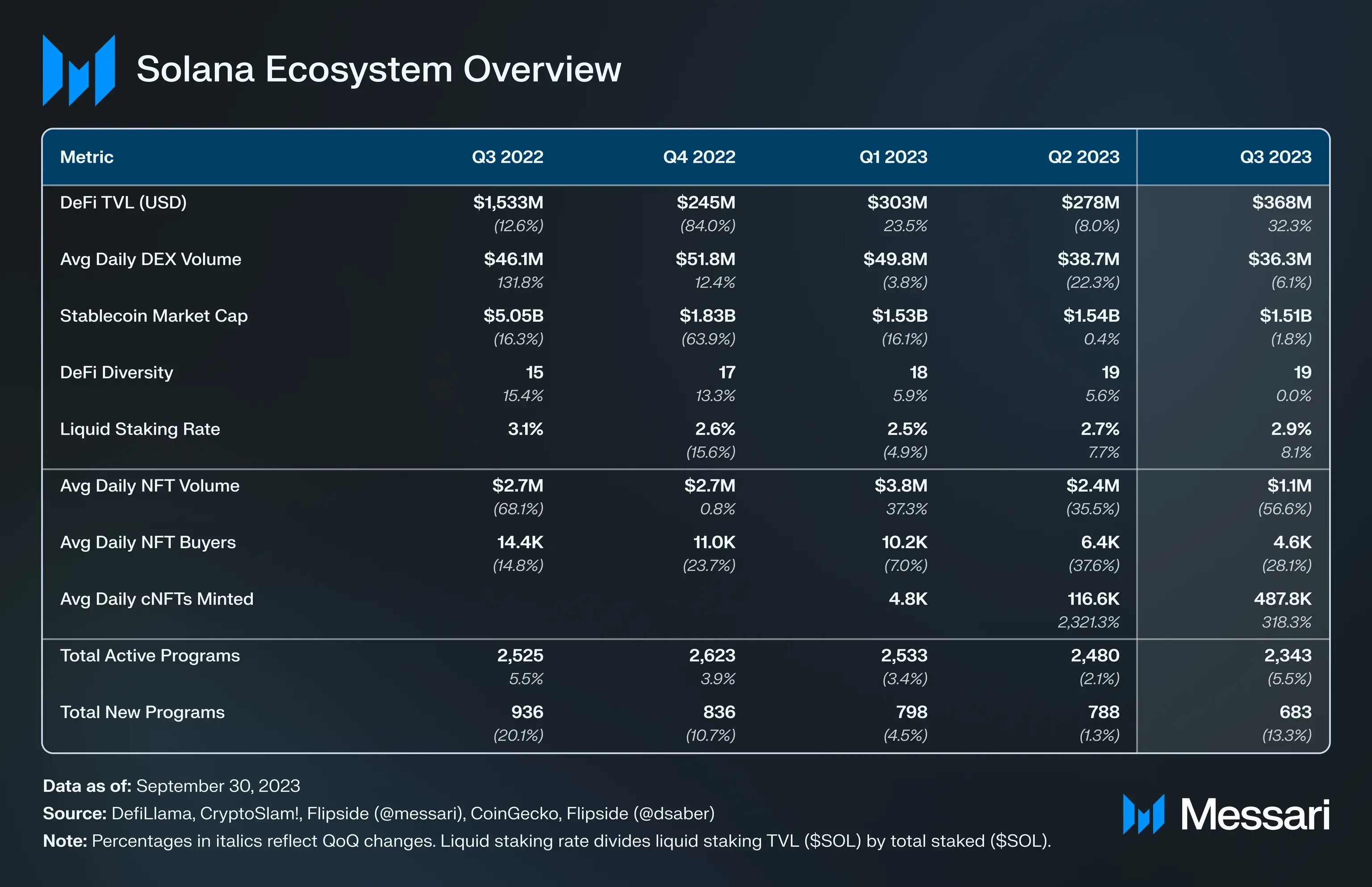
DeFi
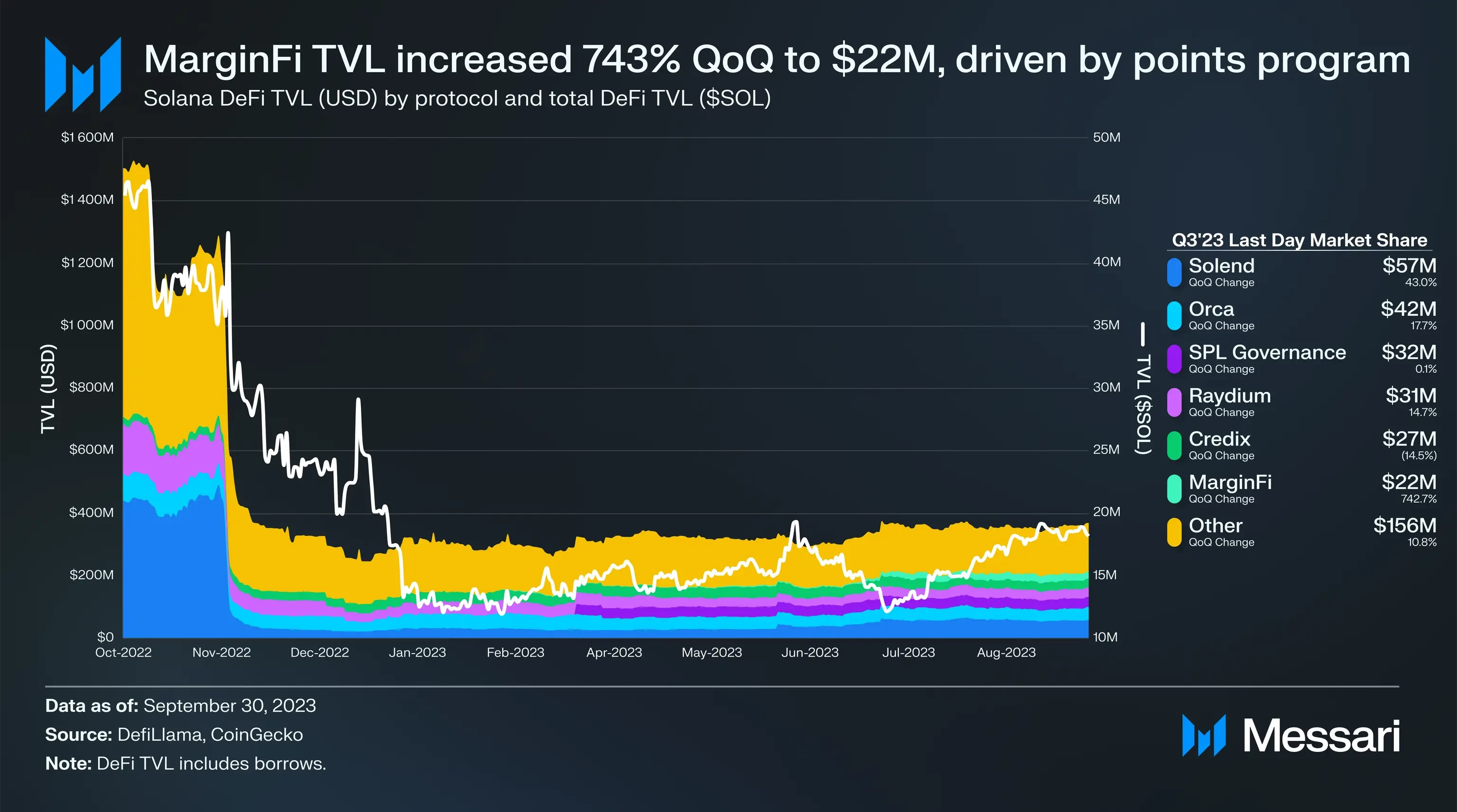
Over the past few quarters, the emerging Solana DeFi protocol has performed well in terms of growth and has been classified as “Solana DeFi 2.0.” The designation represents a token economic model that circumvents the predatory and low-circulation paradigm prevalent in previous cycles. Additionally, most (new protocols) have not yet launched native tokens.
Lending protocol MarginFi is one of the leaders in this trend. On July 3 this year, MarginFi launched a points system that gives users points for depositing, borrowing, and recommending other users. Its total value locked (TVL) grew 743% quarter-over-quarter to $22 million, making it Solana’s sixth-largest protocol. Following this, MarginFi launched its own liquid staking token, LST, information about which will be covered in the “Liquid Staking” section below.
Perps Exchange Cypher also launched its points system in mid-July. Cypher was one of Solana’s fastest-growing DeFi protocols before suffering an attack worth approximately $1 million in early August. To help users recover their losses, Cypher announced that it is accelerating the process of its CYPH Initial Offering (IDO). Over 50% of CYPH tokens will be distributed to the community during the initial issuance and airdrop.
Solana’s lending leader, Solend, launched a points program in early August. Instead of using the points for potential airdrops, Solend is tied to its already launched token, SLND. The first season of Solend Points will last approximately three months, with a minimum reward pool of 100,000 SLND (worth $54,000 as of September 30, 2023). Solends TVL grew 43% quarter-over-quarter to $57 million, driven by the points system.
Other noteworthy DeFi developments include:
Phoenix Release: Phoenix, the central limit order book on the entire chain, was officially launched at the end of August, after completing the beta version in March. The August launch comes exactly a week after Phoenix’s development team, Ellipsis Labs, announced the closing of a $3.3 million seed round led by Electric Capital. Phoenix’s most popular trading pair, SOL/USDC, has averaged over $3.4 million in daily trading volume since launch. Even though its quarter-end TVL of $378,000 was much lower than other exchanges, Phoenix still had the highest volume among the trading pairs.
Drift Growth: Among Solana’s top protocols, perpetual contract exchange Drift was one of the fastest growing protocols in Q3. Drift ended the quarter with TVL of $17.3 million, up 87% sequentially and 976% year-to-date. Drift received several noteworthy upgrades throughout the quarter, including Drift Liquidity Providers, Market Maker Incentives, and MetaMask Snap CONNECT. The CONNECT upgrade allows users to conduct transactions on Drift and cross-chain EVM to Solana from MetaMask. Currently downloaded over 1000 times.
Solflare Snap: Wallet Solflare has launched MetaMask Snap, which has already been downloaded nearly 19,000 times. Snap allows users to store Solana tokens and NFTs, enable EVM to Solana bridging via deBridge, and access Solflare-enabled Solana applications. Solflare also launched an incentive program, SolScout, offering bonuses totaling $100,000 to users who complete daily ecosystem-related tasks through Solflare or its MetaMask Snap.
Jupiter V3: Swap aggregator Jupiter launched its V3 version at the end of July. It uses the new routing algorithm Metis to provide better price discovery capabilities. Jupiter also introduced limit orders, fixed bet functionality and a bridge comparator. Jupiter’s Q3 data on active addresses and trading volume are considered one of Solana’s top DeFi protocols.
Maple’s Return: After halting development on Solana following the FTX crash, Maple Finance returned to Solana in early September, bringing its cash management solution with it. The product offers DAOs and high-net-worth individuals the yield on U.S. Treasuries with a 0.5% reduction in management fees (denominated in USDC). Maple ended the quarter with $4.2 million in TVL on Solana.
Circuit launch and funding: In August, Circuit launched a private beta of Circuit Vaults and announced a funding round in which companies like Multicoin participated. Circuit has partnered with Drift to allow users to deposit funds into Supercharger vaults to access unbiased automated market maker strategies deployed on Drift.
There are more developments coming, including tBTC integration, Credix’s USDC receivables pool, Kamino Creator Vaults (Kamino launched Kamino Lend shortly after the quarter ended), Zeta V2, and the launch of the EUROe stablecoin.
Liquid Staking
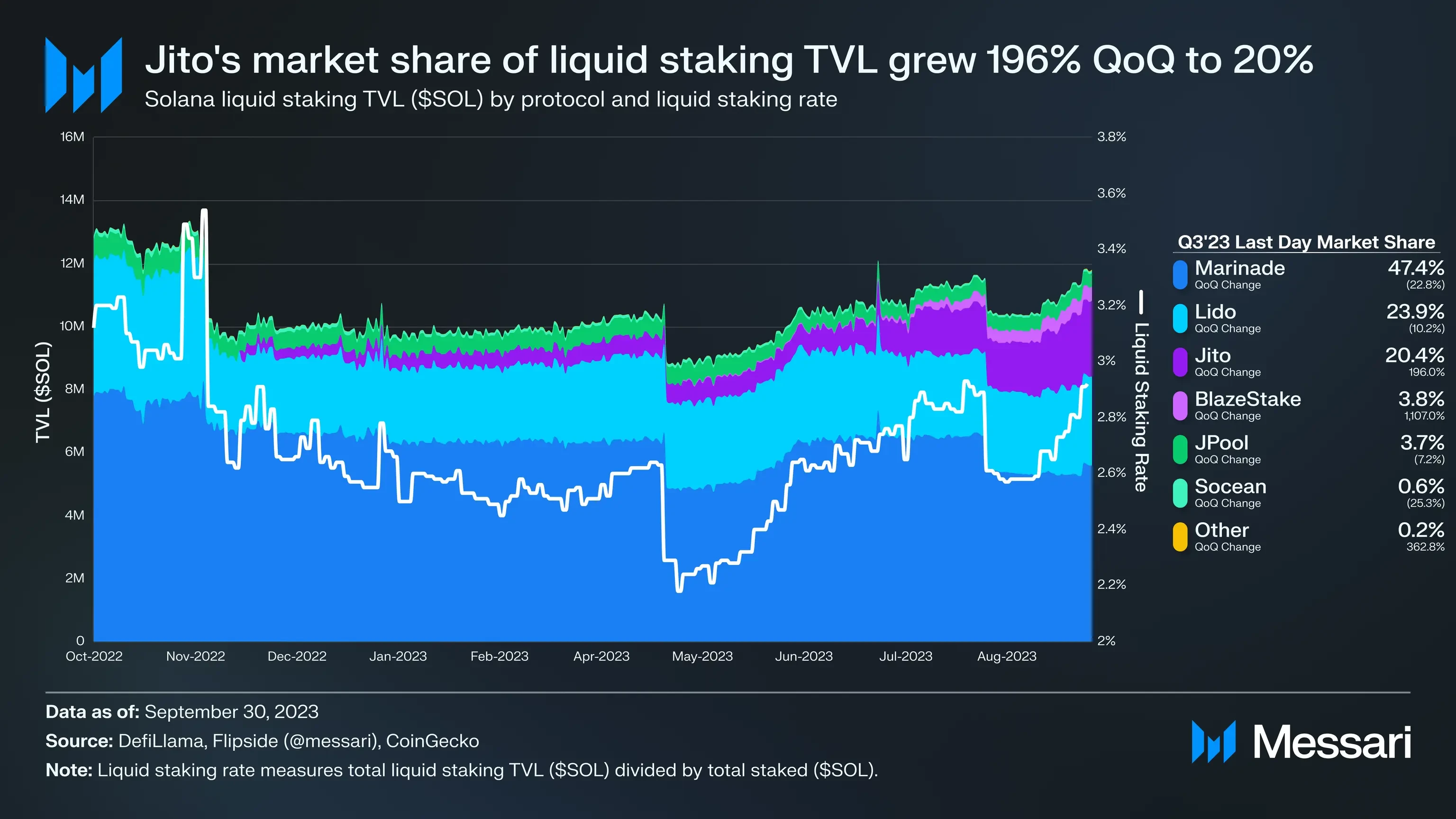
A large portion of the SOL in the Solana ecosystem is not participating due to the large amount of SOL being locked or in liquidity staking. Liquid staking protocols have been working to stimulate more SOL participation through incentive programs to complement similar incentive trends in the DeFi ecosystem.
Liquid staking protocol Blaze has been hinting at an airdrop to bSOL holders since last year. In early August, it launched a points system that provides points to users who hold bSOL and bonus rewards for users who use bSOL in DeFi protocols. Shortly after, Blaze launched its token, BLZE, with airdrops based on users’ points. Representing Solana DeFi 2.0, 64.5% of the BLZE supply will be released to users through an initial airdrop and ongoing rewards. As of September 30, 2023, Blaze’s value locked (TVL) in SOL increased by 1234% quarter-on-quarter to 452,000 SOL (valued at $9.2 million).
Jito launched its referral program at the end of August and its points system in mid-September. Similar to Blaze, Jito provides rewards to JitoSOL holders and increases their points for DeFi activities. Jitos TVL on SOL grew 227% quarter-over-quarter to 2.4 million SOL (valued at $48.8 million as of September 30, 2023). At the end of the quarter, approximately 35% of JitoSOL was locked in the app rather than in a wallet, compared to 13% at the beginning of the quarter.
Similar to the DeFi ecosystem, Marinade, a pioneer in liquid staking that already has tokens, launched an incentive program in mid-September to match the growth of the new protocol. Marinades TVL on SOL gradually declined throughout the quarter, but reversed upward after September 20. Marinade also launched Marinade Native at the end of July, a native liquid staking product that complements Marinade liquid staking. Marinade Native is an automated staking platform that routes staking to over 100 high-performing validators without users paying performance fees or taking on any smart contract risk.
As mentioned above, MarginFi launched its own LST token at the end of the quarter, called LST. LST routes staking to three validators run by the MarginFi team. Unlike other liquidity staking providers, MarginFi sacrifices a certain degree of decentralization in exchange for higher staking yields. These three validators use the JitoLabs client to deliver MEV-enhanced rewards to LST holders and offer a 0% commission rate. The MarginFi team has also hinted at launching a stablecoin backed by LST.
After the quarter ended, as Lido, which accounts for nearly 24% of the liquid staking TVL market share, passed the proposal to terminate self-funding of Solana, this will provide other protocols with a significant opportunity to absorb its share.
The liquid staking ecosystem is further enhanced through protocols such as Super Stake and Sanctum. Super Stake was launched at the end of Q2 and increased LST returns through the recursive lending strategy on Drift. It added support for JitoSOL in Q3, joining mSOL. Both Super Stake vaults are currently full. Sanctum(Formerly unstake.it) provides liquidity and stability to Solana’s liquid staking and DeFi ecosystem. It provides instant liquidity for locked SOL (bypassing the unlocking period) and a “safe harbor” SOL pool for closing loans with LST as the collateral token.
consumer
NFTs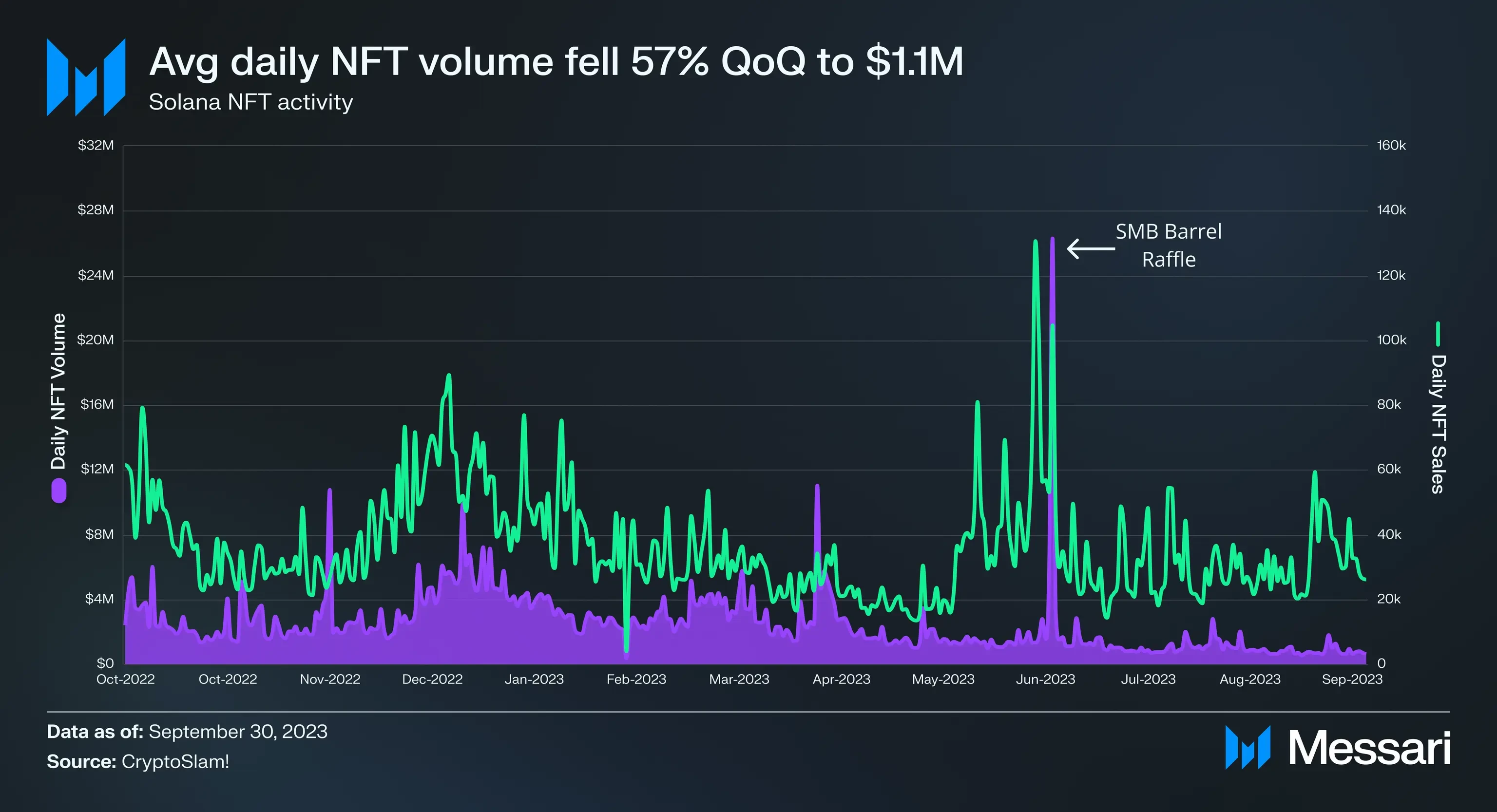 On the last day of Q2, after the Solana Monkey Business draw led to a surge in NFT trading volume, the average daily trading volume of NFTs fell 57% quarter-on-quarter to $1.1 million. Sales and the number of unique buyers also fell year-over-year.
On the last day of Q2, after the Solana Monkey Business draw led to a surge in NFT trading volume, the average daily trading volume of NFTs fell 57% quarter-on-quarter to $1.1 million. Sales and the number of unique buyers also fell year-over-year.
Important NFT developments this quarter include:
Tensorians, Meegos, Reavers, Gates of BroHalla and Mint of VTOPIANS, among others.
On September 23, the NFT series of the virtual horse racing game Photo Finish LIVE became the series with the highest circulating market value on the Solana market. The event is likely in anticipation of its fourth virtual Kentucky Derby (officially licensed), which takes place on September 23. However, by the end of the quarter, Mad Lads regained its position as the top company by market capitalization.
Magic Eden regained most of its market share at the end of the quarter, surpassing Tensor, which started the year with 1.2% market share and reached a high of over 74% in early August.
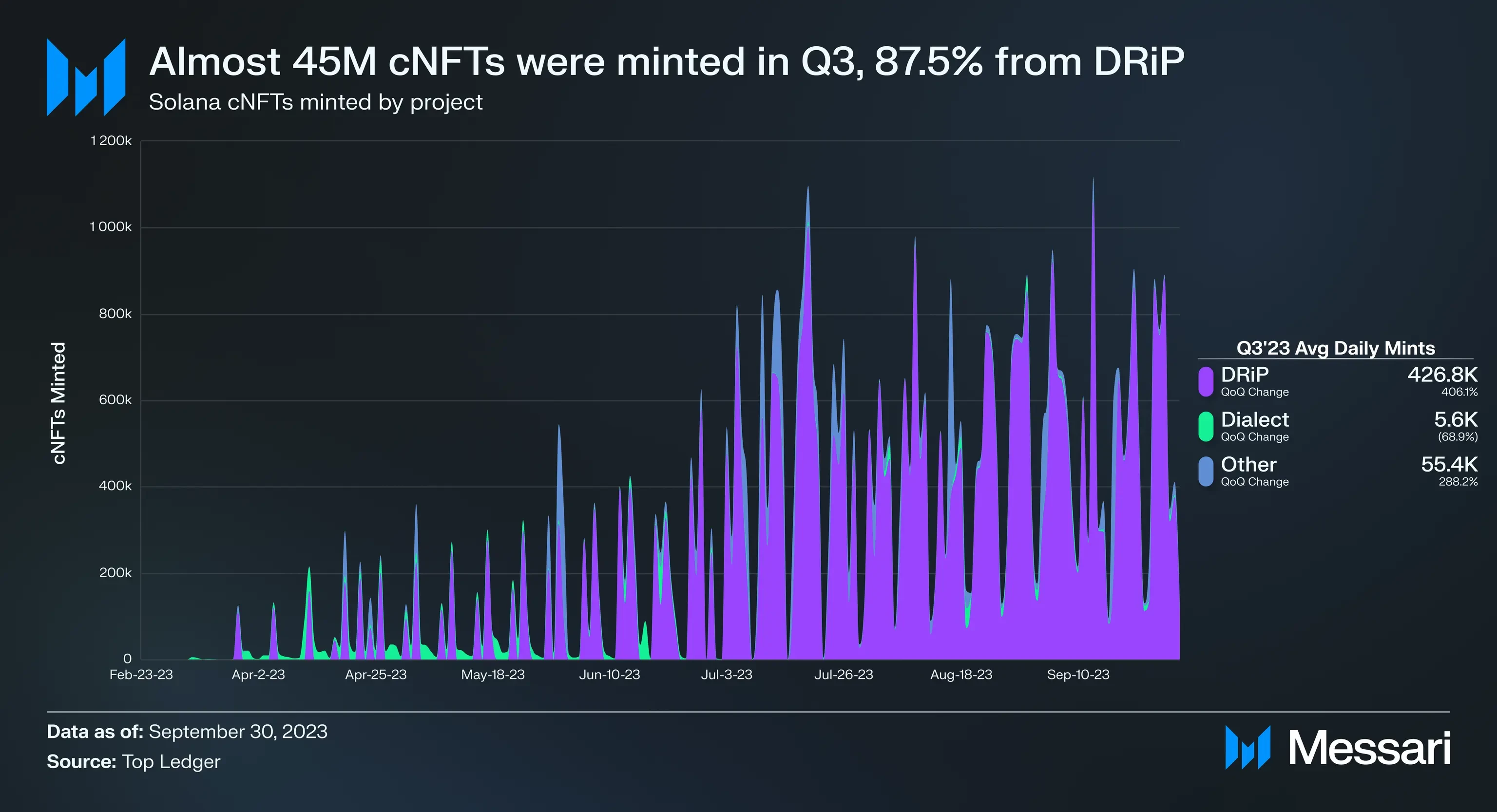
At the beginning of Q2, Solana launched a state compression upgrade. This upgrade provides a cost-effective way to store data on-chain by hashing it into a Merkle tree and publishing its root hash on-chain. Its first major use case was the compressed NFT (cNFTs) standard created by Metaplex: 1 million cNFTs were minted and stored with state compression at a cost ranging from 5.3 to 63.7 SOL, which would have been 1 million without state compression. It will be 24,000 SOL.
A total of nearly 45 million cNFTs were minted in Q3, a 316% month-on-month increase. DRiP occupies the vast majority of the market share, accounting for 87.5%. DRiP works with artists to mint free NFT art, with collections much larger than the typical 10,000. In mid-August, DRiP announced the completion of a $3 million seed round led by Placeholder.
Dialect is another major cNFT use case. Dialect is a Web3 messaging application that uses cNFT for Dialect stickers. In early September, Dialect launched a web application.
As mentioned above, Tensor launched its own Tensorian cNFT series in August. Users need to mint Tensorian through the Tensorian Shards mechanism, and these Shards will be issued to users as airdrop rewards in the second season. Currently, the total trading volume of Tensorians and Tensorian Shards in Q3 is approximately $7 million.
Tensor has been the leading marketplace for cNFT trading since launching support in May 2023. However, Magic Eden hopes to change that, adding cNFT support in mid-September. But since Magic Eden integrated cNFT, Tensor has retained almost 97.2% of the transaction volume market share.
Another new use case for cNFT emerged in early September, when developer kiryl launched a cNFT multi-burning tool. September’s Burning Man mission incentivized users to burn specific cNFTs for a chance to win prizes.
game
In addition to Photo Finish LIVE, other notable game developments include:
Star Atlas SAGE Labs: Star Atlas launched early access to its SAGE Labs open-world game in late September, giving users the chance to compete for a $1.2 million prize. Since every action occurs on-chain, SAGE has become an important component of Solana’s overall transaction volume.
Bonk SVB: On August 1, the meme coin Bonk launched Silicon Valley BONK (SVB), an on-chain lottery game where users compete to purchase keys and become the last person to purchase keys. If they win, they will receive key purchase funds. a part of.
The Heist Season 2: Popular idle game The Heist returns with Season 2 in mid-August, introducing a new in-game currency and NFT collection. In mid-September, the game added mobile support. Currently, The Heist leads all NFT series in Q3 trading volume.
social contact
One of the most important events of Q3 in all of crypto was friend.tech, which showcased the potential of social apps to become breakout applications for cryptocurrencies. Solana’s social applications include:
Access Protocol: Access is a creator revenue platform. 21 new creators were added in Q3, bringing the total to 38. Total subscribers doubled quarter-on-quarter to 227,000.
Solarplex: Web3 social media platform Solarplex opened the V2 version in mid-August and gained initial attention.
SolLinked: “The LinkedIn version of friend.tech” proposed by Solana Labs co-founder Anatoly Yakovenko in mid-August. A week later, developer darksoulsfanlol set up the platform. SolLinked allows users to set up email and calendar accounts and set prices for email responses or calendar bookings, paying using TipLink and USDC.
Friendzy: Friendzy is a more traditional fork of friend.tech whose keys can be traded before the account is enabled. After launching in mid-September, Friendzys total locked value peaked at $190,000 on September 26, but fell to $76,600 by the end of the quarter.
Hub 3: Hub 3 is another friend.tech spinoff that adds features like group chats, discovery tools, and an NFT whitelisting service. It launched on September 24, with activity ramping up after the quarter ended.
DePIN
Solana is becoming the centerpiece of DePIN applications, including Helium, Hivemapper, Teleport, Render (planned to move to Solana), and GenesysGo, among others.
Notable Q3 events include:
Helium: Helium is a decentralized wireless network migrating to Solana in April 2023. In mid-August, Helium Mobile, which utilizes the network, launched a $5-a-month unlimited phone plan, initially limited to Miami residents.
Hivemapper: Hivemapper aims to create a decentralized global map. At the end of August, it launched Hivemapper Bursts, which offer additional HONEY rewards for mapping hotspots at customer request. Hivemapper mapped over 1 million unique miles of road in Q3, for a total of over 3.3 million miles.
pay
Payments is another emerging use case on Solana, with some important achievements this quarter, not least the integration of Visa and Shopify.
In early September, Visa announced the expansion of its USDC settlement pilot program to Solana. Visa’s cryptocurrency team published an in-depth analysis on Solana, highlighting why they believe Solana can help drive mainstream payments processes. Reasons include Solana’s low and predictable fees via the local fee market, parallel transaction processing, fast transaction confirmations, large number of nodes, and multiple validator clients.
In late August, Solana Pay integrated with Shopify, allowing Shopify merchants to accept Solana’s native USDC. Shopify accounts for about 10% of the total e-commerce in the United States. Compared with the standard rate (credit card) of 1.5% -2.5%, the entry of Solana Pay gives merchants an almost free alternative in credit card selection.
Other noteworthy payments developments include:
TipLink Gift Cards: TipLink allows users to send Solana tokens through a link. In mid-September, it added the ability to purchase gift cards using cryptocurrency, giving users who received cryptocurrency through a link a way to withdraw funds.
Beam: Offramp Beam went live in mid-August and supports Solana as well as several other networks. This was followed by the launch of an SDK at the end of the month, allowing developers to easily integrate the solution into their applications.
CandyPay Mobile SDK: CandyPay allows apps to enable Solana tokens at checkout. In mid-August, it launched its mobile SDK.
Meso SDK Early Access: Meso has opened up its SDK early, enabling developers to integrate its entry products into their applications.
Helio WooCommerce Partnership and Wallet: Multi-chain payments platform Helio and WooCommerce partnered in early September to power cryptocurrency payments on WordPress. A week later, it launched its own self-hosted Solana wallet, which users can log in using email or Web2 social accounts.
privacy
Solana has quietly grown more and more privacy protocols. In addition to the core zero-knowledge (ZK) upgrades in V1.16, Q3 developments include:
Light Protocol: Light Protocol is a zero-knowledge layer on Solana for building Private Solana Programs (PSPs). Light Protocol uses UTXO method to achieve privacy. It also uses private state compression, so private transactions cost exactly the same as regular Solana transactions. In early August, it released its first reference implementation based on PSPs.
Elusiv: Elusiv is another privacy layer that takes a shared pool approach. In late August, Elusiv launched private token swaps that use ephemeral keys to decouple the link between a user’s public key and their transactions. Elusiv interchange uses Jupiter liquidity.
develop
The ecosystem has been fueled by the resources and infrastructure built by Solana Labs and independent companies like Helius and Ironforge.
Key releases for the third quarter include:
GameShift: Solana Labs released the GameShift API in mid-July to simplify Web3 game development.
Helius Pyre: In mid-July, Helius launched Helius Pyre, an open source platform that takes a gamified approach to learning Solana development. Helius also released Test Drive, a Postman-like open source tool for testing RPC, with documentation and examples.
Solana Curriculum: freeCodeCamp has released a free developer course to help developers become familiar with Solana development by building 15 projects.
Synthetic Assets Platform Implementation:: At the end of the quarter, Solana Labs released a reference implementation of an open source synthetic assets platform.
Other developments: The Graph integration, Ironforge’s Playground, four new Solana development courses, Ellipsis’ Verified Builds tool, and Magicblock’s fuel-free RPC API for game development.
increase

Grants, hackathons, accelerators, and other initiatives sponsored by the Solana Foundation and independent organizations such as Lamport DAO and Superteam further grow the ecosystem.
Important events in the third quarter include:
OPOS Hackathon: Only Possible on Solana (OPOS)Hackathon is a community-run event organized by Lamport DAO and takes place in August. More than 600 participants in 25 fields competed for a $100,000 prize offered by 40 sponsors. It was held offline, concurrently with mtndaos Hacker House. The current top prize winners are Onda Protocol ($10,000, Compression track) and Ned Finance ($10,000, Jupiter track).
Hyperdrive Hackathon: Solana Foundation’s online Hackathon event, starting in early September. More than 5,000 developers will compete in seven fields for up to $1 million in prizes and seed rounds, with the competition running until October 15.
Hacker House: Solana The 2023 Hacker House Circuit, sponsored by Jump Crypto and Circle and the Solana Foundation, provides a place for developers to build, find partners, and learn from community members. This quarter’s Hacker Houses are held in Berlin, Bangalore and Mumbai.
PlayGG: The Solana Foundation hosts the games festival PlayGG in mid-July. The event included demos, live streams, competitions, and workshops, highlighting dozens of Solana-based games.
Additional events and initiatives include the launch of Layer 3 of the Quest Platform, the Solana Summer Festival, sessions on how to host a Solana Developer Workshop, accelerator Solana University’s Demo Day, and the Monacode Hackathon.
Upcoming Q4 events include Solana’s annual Breakpoint conference, Hong Kong Hacker House, Encode Club’s Solana Accelerator, Berlin Demo Day, and more.
Summarize
Especially considering the bear market, the Solana ecosystem was active and growing rapidly in Q3 across DeFi, liquidity staking, consumer, DePIN, and privacy protocols. Compressed NFTs (cNFTs) are becoming a popular use case for state compression, with the number of cNFTs minted growing by 316% in the third quarter to nearly 45 million. Free collectibles distributor DRiP accounted for 87.5% of these mints. Bucking the market trend, Solana’s DeFi TVL increased by 32% in Q3 to $368 million. This growth has been driven primarily by points programs launched by DeFi and liquidity staking protocols, including MarginFi, Jito, Cypher, and BlazeStake, among others.
Solanas underlying technology is also attracting attention and adoption from outsiders. Examples from Q3 include Rune exploring Solana fork MakerDAO, L2 Eclipse going live, and Visa’s payments integration on Solana. Additionally, Solanas technology continued to improve during the quarter. The V1.16 upgrade reduces validator memory requirements, introduces functionality and features required for confidential transfers, and improves support for zk proofs.
Finally, SOLs market cap grew 17% in the third quarter to $8.4 billion. The increase comes amid concerns that FTX may liquidate its 57 million tokens, which were approved at a pre-trial hearing in mid-September, although FTX/Alameda’s SOL is subject to various unlocking plans, with an average unlock date of Q4 2025. However, these locked tokens can still be traded over-the-counter. Nonetheless, Solana’s network and ecosystem are expected to be stronger than when they entered the bear market.










